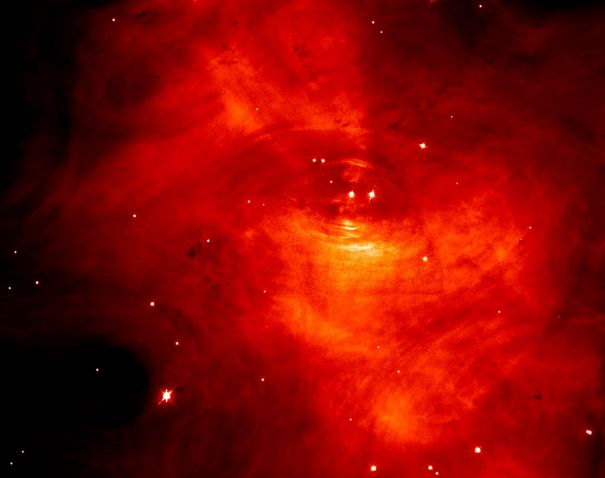Explanation: In the Summer of 1054 A.D. Chinese astronomers reported that a star in the constellation of Taurus suddenly became as bright as the full Moon. Fading slowly, it remained visible for over a year. It is now understood that a spectacular supernova explosion - the detonation of a massive star whose remains are now visible as the Crab Nebula- was responsible for the apparition. The core of the star collapsed to form a rotating neutron star or pulsar, one of the most exotic objects known to modern astronomers. Like a cosmic lighthouse, the rotating Crab pulsar generates beams of radio, visible, x-ray and gamma-ray energy which, as the name suggests, produce pulses as they sweep across our view. Using a stunning series of visible light images taken with the Hubble Space Telescope (HST) in 1995, astronomers have discovered spectacular pulsar powered motions within the Crab nebula. Highlights of this HST Crab "movie" show wisps of material moving away from the pulsar at half the speed of light, a scintillating halo, and an intense knot of emission dancing, sprite-like, above the pulsar's pole. Only 10 kilometers wide but more massive than the sun, the pulsar's energy drives the dynamics and emission of the nebula itself which is more than 10 light-years across.
1999 2000 2001 2002 2003 2004 2005 2006 2007 2008 2009 2010 2011 2012 2013 2014 2015 2016 2017 2018 2019 2020 2021 2022 2023 2024 2025 |
Yanvar' Fevral' Mart Aprel' Mai Iyun' Iyul' Avgust Sentyabr' Oktyabr' Noyabr' Dekabr' |
NASA Web Site Statements, Warnings, and Disclaimers
NASA Official: Jay Norris. Specific rights apply.
A service of: LHEA at NASA / GSFC
& Michigan Tech. U.
|
Publikacii s klyuchevymi slovami:
Sverhnovye - ostatok Sverhnovoi - neutron star - pulsar - Crab Nebula - supernova - Pul'sar - Krabovidnaya tumannost' - gamma-izluchenie
Publikacii so slovami: Sverhnovye - ostatok Sverhnovoi - neutron star - pulsar - Crab Nebula - supernova - Pul'sar - Krabovidnaya tumannost' - gamma-izluchenie | |
Sm. takzhe:
Vse publikacii na tu zhe temu >> | |
